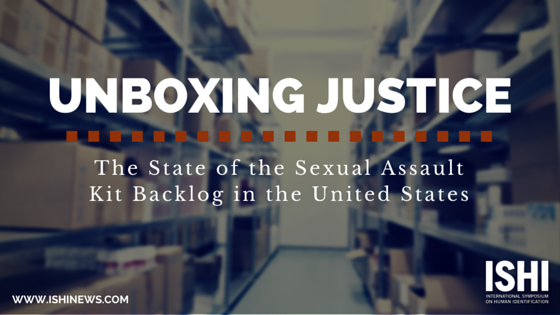If you’ve watched or read the news at all over the past year, you know that reducing the sexual assault kit backlog has been simultaneously a top concern and priority across the nation. In July of 2015, USA Today partnered with journalists from 75+ Gannett newspapers and TEGNA TV stations to “perform the most detailed nationwide inventory of untested rape kits ever”. They uncovered at least 70,000 untested kits in an open-records campaign covering more than 1,000 police agencies. The story notes that “despite its scope, the agency-by-agency count cover[ed] a fraction of the nation’s 18,000 police departments, suggesting the number of untested rape kits reach[ed] into the hundreds of thousands.”
Written by: Tara Luther, Promega Corporation
More recently, End the Backlog reports that few state governments and no federal agencies track rape kit data, so we don’t really know how the numbers currently stand. The site does include a helpful map showing the status of the backlog by state. Read on as we begin our in-depth look at the sexual assault backlog.
2015: USA Today performs nationwide inventory of untested rape kits; likely is hundreds of thousands.” Share on X
What is the backlog?
The rape kit backlog exists in two places, the first being evidence storage facilities where a rape kit is booked into evidence but DNA analysis has not yet been requested, and the second being in crime labs where tests await DNA analysis. The Joyful Heart Foundation defines a backlogged kit as one that has either not been submitted to an accredited public or private crime lab within 10 days of being booked into evidence, or a kit that has been submitted to a crime lab, but has remained untested for more than 30 days.
It is important to note that a portion of the backlogged kits exist because they were created prior to the creation of the Combined DNA Index System (CODIS), which became fully operational in the late 1990’s. Processing kits where the offender was a stranger prior to CODIS would not be as fruitful as there were no offender profiles available for comparison. Processing these older kits is challenging when analysts with limited resources are working to process recent crimes as well.
Why does the backlog exist?
End the Backlog lists two main reasons for why the rape kit backlog exists. The first is a lack of resources for both the police and crime labs. On average, a kit costs between $1,000 – $1,500 to test. A lack of funding for crime labs combined with an increased workload has strained these labs and contributed to the pile up of kits. These same conditions have effected police departments as well. Law enforcement agencies lack personnel needed for shipping untested kits to labs, tracking kits once they’ve been submitted, and following up on leads resulting from rape kit testing.
The second reason End the Backlog lists is detective discretion. Often, the decision on whether or not to submit the kit for testing lies with the officer assigned to the case. The detective may base their decision on the following factors: whether or not the department prioritizes sexual assaults in contrast to other crimes, whether the case is likely to move forward, and whether the identity of the perpetrator is known.
What challenges exist in reducing the rape kit backlog? Click to learn more! Share on X
What additional challenges exist in bringing offenders to justice?
Even in the event a rapist is identified, there may be a chance that they are not brought to justice. As statutes of limitations vary by state, it’s possible that these backlogged kits may not be tested soon enough. Currently, 43 states have statutes of limitations ranging from 3 – 12 years, though 27 of them include an exception allowing prosecutors to file charges when DNA evidence is available.
Some states, including California, Illinois, New York, Oklahoma, and Pennsylvania are currently looking at bills that would either extend statutes of limitations for rape and sexual assault, or eliminate them altogether. In some cases, these laws have already been introduced. In Nevada, for instance, the statute of limitations has been extended from 4 to 20 years. Oregon took a different approach, allowing prosecutors to file charges after the statute of limitations has expired if there is new evidence, or if multiple witnesses come forward.
As statutes of limitations vary, possible that backlogged rape kits not tested soon enough. Share on X
How do victims feel their cases are being handled?
A new study is being performed by Katherine Lorenz, a doctoral student in the Department of Criminology at the University of Illinois at Chicago to determine how sexual assault investigations can be improved upon from the perspective of victims. The study involves confidential, one-hour interviews, in which the women are asked about their contact with police, how the investigation proceeded, and the reason they decided to cooperate or not to cooperate with detectives. The study, which will run through 2016, already has 100 participants. Lorenz hopes that the study will shed light on new ideas about ways to communicate with sexual assault victims and improve the overall investigation of the crime.
To quote Vice President Joe Biden, “Rape kits are an essential tool in modern crime fighting — not only for the victim, but, for the entire community. Studies show we solve up to 50 percent of previously unsolved rapes when these kits are tested. When we solve these cases, we get rapists off the streets. For most survivors, seeing their rapists brought to justice, and knowing that they will not return, brings peace of mind and a sense of closure.”
Be sure to check back on the blog next week as we examine what’s being done on a Federal and State level to reduce the sexual assault kit backlog and bring these offenders to justice.
WOULD YOU LIKE TO SEE MORE ARTICLES LIKE THIS? SUBSCRIBE TO THE ISHI BLOG BELOW!


